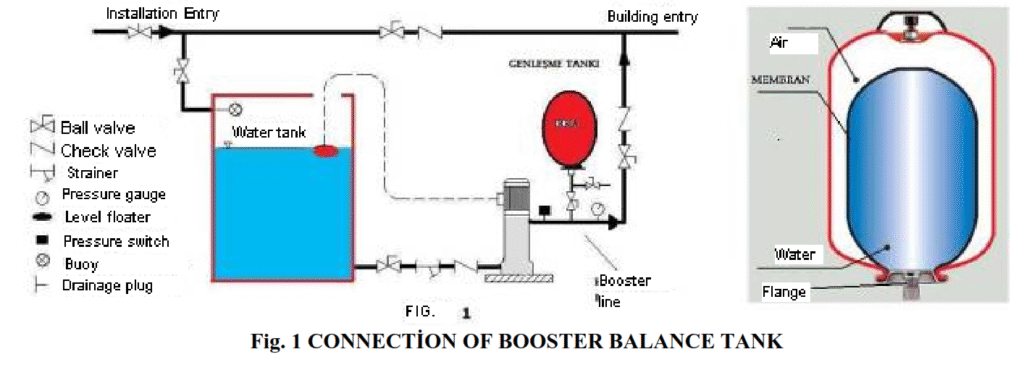Pressure tank
Principle use pressure tank
Reducing the running time of pumps in booster systems, preventing the water hammer in installations and storing ready-for-use pressurized water are among the main tasks of a booster pressure tank.
The volume and the pressure class of the booster pressure tank depends on the specifications and application requirements of the booster set. However, in determining the volume the number of motor cycles should also be taken into consideration.
The pressure vessels contain an exchangeable EPDM diaphragm (membrane) that does not make any odor in the water and that is completely suitable for human health. This diaphragm is encircled with pressurize air or nitrogen gas.
With the rise of the pressure inside the installation the fluid fills under the gas pressure in the diaphragm. Thus, a portion of the fluid in the system would be stored under pressure inside the booster pressure tank. In case where the pressure is reduced with the use of water in the installation the fluid inside the pressure tank is being pushed back into the system with the help of the pressurized air outside the diaphragm. Therefore, the greater the
volume of the tank the less the pump will be activated.
All tanks are protected against corrosion and covered with electrostatic epoxy powder coated paint. The inner surface of the tank is absolutely not in contact with water unless the diaphragm is damaged.
Apart from the quality of balance tank to be used, the pressure of the diaphragm and the tank volume are also very important for the booster set. In case you select a too small sized expansion tank it would cause that the pump gets activated too often, which could result in a wear out of the tank in a short period of time. On the other hand, a tank that is sized too big would increase unnecessarily initial investment costs.

ADVANTAGES OF CLOSED EXPANSION TANKS
1.Since the heating system will turn into a closed system there will be no contact with air and corrosion will be reduced.
2.Since there is no water loss in closed heating systems due to water evaporation and therefore heat loss will be reduced. Additionally there will be no water loss and this means there will be no water in the system and thus no new calcification. For this reason there will be no heating problems due to calcification and as a result less fuel costs.
3.In a closed system the pressure distribution will be equal and thus the heating of each radiator will be more equal as well.
4. In the closed system water will be heated under pressure and this would increase the efficiency and gain additional fuel savings.
5. Since the vessel would be installed adjacent to the boiler you would save the pipe material leading to the roof, isolation material, space that would be required for the pipes and labor costs. The risk of frost would be avoided. Additionally you would gain roof space etc. and benefit from architectural aesthetics.
CALCULATION OF THE TANK’S PRESET PRESSURE
Static Pressure; P static = Static height[m] /10 25 / 10 = 2,5 bar
Pre-set gas pressure; Ppr = P static + 0,2 bar 2,5 + 0,2 = 2,7 bar
System operational pressure; PF = P0 + 0,3 bar 2,7 + 0,3 = 3 bar
Tanks should be pressurized with dry air by using a compressor with sufficient pressure capacity. When checking or adjusting the pre-set gas pressure the water inside the tank must be discharged.

Leave a Reply